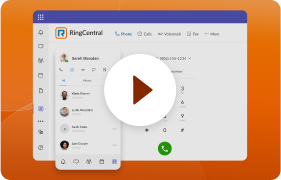The way you communicate with your customers sets the stage for how your brand is perceived. Are you friendly, formal, empathetic, entertaining, or informative? Your agent may have provided a satisfactory resolution, but what about the journey they facilitated? Developing a consistent customer service voice ensures your team provides better experiences.
Tone and voice shape customer interactions, strengthening or weakening relationships. They can turn potential negative experiences into positive ones. This can also work in reverse, with 73% of consumers switching brands after multiple negative experiences.
If you’re not sure about customer service voice and tone, you’ve come to the right place. In this guide, we’ll explain how you can promote consistent communication that better connects with your customers.
⭐️⭐️⭐️⭐️⭐️ Ready to offer 5-star customer service? Get strategies for every stage of the customer journey with this free eBook.
What is customer service voice?
Your customer service voice is a critical pillar of your brand persona. It’s the style, color, and character your team uses when communicating with customers. Your company voice is made up of language, tone, and other elements that convey your unique brand personality.
The voice in customer service you curate depends on factors such as the industry and target audience. Voice should also reflect the values and ethos of your business. How do you want to be perceived in the marketplace? Are you a thought leader or a hip and trendy brand?
In other words, your customer service voice reinforces your overall brand image, resonates with your customers, and helps differentiate you from competitors.
The importance of tone of voice in customer service
Consistency and trust are intertwined. When customers receive the service they expect, they get a better experience. Let’s examine why tone of voice matters in customer service interactions.
It helps build your brand identity
A brand identity is crucial to connecting with your target audience. A distinctive customer service voice is instantly recognizable. For example, let’s say you’ve trained your team to take a casual, informal tone. When responding to a customer complaint, they might say something like “Wow, we really screwed up there. Don’t worry, I’m here to help you solve this problem right now.”
In contrast, another brand may want a direct, professional tone for B2B customer service. They’re more likely to encourage a response like “thank you for making us aware of your issue. We will do our best to resolve it as quickly as possible.”
Your chosen tone connects with customers by reinforcing the brand persona they love and expect.
It improves customer experiences
A consistent tone of voice creates clarity and better understanding. When customers know what to expect, there’s little to no room for confusion.
A defined customer service tone of voice guides your agents to interact with customers effectively. It also helps them tailor conversations to each individual while maintaining consistent quality standards.
It sets the mood of customer conversations
The tone of voice sets the mood for a conversation. While the overall voice of your brand creates a targeted perception, the tone adds immediate context and personalization. The way your team speaks or writes to customers shows whether they understand the gravity of the situation and empathize.
How to improve tone of voice in customer service: Building your customer service voice
One of the customer service skills your team needs is an understanding of how to use tone of voice. Recent research shows that customers really care about how customer service staff speak to them. According to The State of Customer Service and CX report:
- 89% of customers want staff to be kind and helpful
- 79% want their experience to feel personal
- 78% want staff to show understanding and empathy.

How, then, can you go about instilling the things that matter to customers into your customer service voice?
1. Be clear about your brand identity
Developing a unique customer service voice starts with a clear understanding of your brand identity. It serves as the foundation for how your team interacts and communicates with your audience. Customers want to know what to expect when reaching out to your support and sales teams.
Being upfront and authentic about your brand identity strengthens trust and customer relationships. Think about:
- Core values and mission – Be transparent about the core values and mission of your organization. Use marketing channels, such as social media, to communicate how your company speaks and what it stands for.
- Brand personality – Identify a brand personality, such as “friendly and informative” or “helpful and humorous.” Create a brand style guide to align overall written and spoken customer communication for your team.
- Visual identity – Develop a visual identity that is instantly recognizable and which conveys your brand’s personality and values. This will help make your brand more memorable and resonate with your audience. For example, consistent logos, colors, and fonts in self-service portals or live chat reinforce your brand identity.
By establishing a strong brand identity, you lay the groundwork for a consistent and effective customer service voice that better connects with your audience.
2. Define an appropriate tone of voice
Your brand identity serves as the overall persona of your business and its customer-facing team members. Next up is to develop an appropriate tone of voice for customer service and support.
What’s the difference between tone and voice?
- Voice – The consistent personality and style of your brand. This ties back to your strategically chosen brand identity. Voice remains consistent and reflects the core values of the company.
- Tone – The attitudes and emotions projected to your customers. The tone of voice adds context to written and spoken conversations. It also adds personalization while maintaining your brand identity. Your customer service team should shift tone according to the audience and the situation.
So, how do you choose the right tone of voice?
First off, customer service tone of voice should always align with and bolster your brand identity. If your brand is known as an informative industry leader, a less casual and straightforward tone would be appropriate. In contrast, if your brand is known as a whimsical, entertaining brand, customers would expect a less formal and amusing tone of voice.
That’s only the surface level of course. Tone also needs to be tailored to factors such as:
- Platform or channel – Is the conversation taking place over the phone, via email, or on a different channel?
- Audience – Who are your target customers and what are their expectations?
- Emotional context – The emotional state of the customer. Are they calm and patient or stressed and upset?
- Purpose – The primary reason for or issue that spurred the interaction. The tone agents use should reflect an understanding of the situation and its urgency.
3. Develop a style guide
You can improve customer service in a call center and via other channels by giving your team a roadmap. Develop a comprehensive voice style guide that empowers your agents.

A customer voice style guide should include:
- Overall style – Guidelines on overall voice including language and brand personality. This section should reflect your brand identity and set the table for all customer communications.
- Buyer or customer personas – Detailed and fictional personalities that segment customers. These help your team better understand who will likely be getting in touch and what they value.
- Outline tone variations – Determine how your team can interpret customers, tailoring tone of voice to specific moods and complaints.
- Examples – Use real-world examples to guide agents on using voice and tone. Consider using customer service software that features call recording for coaching and training your agents.
- Regular updates – While brand voice should be consistent in the long term, customer service voice needs to be tailored for positive experiences. Gather customer feedback on support channels and adjust your guidelines accordingly.
A guide on its own can be a useful reference for your team. You should also support your style guide with scheduled meetings and training to instruct your team on voice and tone. Gather agent feedback and simulate customer conversations in practice sessions.
4. Leave room for adaptability
While guidelines are useful, it’s important to remember that they are there to guide your team. They help with basic tactics and knowledge to maintain a consistent brand voice and deliver excellent customer service. However, this doesn’t mean you shouldn’t leave room for interpretation and adaptability.
It’s common to use templates and scripts. These are great for creating repeatable interactions that stick to your standards and personality. Build customization and personalization into chat, email, and call templates. These empower your agents to own the message and be authentic with customers.
Adaptability is also crucial to customer satisfaction. If a customer is frustrated, they’ll likely expect a gentle, empathetic tone of voice. If someone is in a rush they’ll expect direct and concise communication.
It’s up to your agents to adapt to circumstances while adhering to overall guidelines.
Adapting tone of voice in customer service to different circumstances
Customer service requires your team to quickly assess a situation and decide on the best course of action. This includes adjusting tone of voice on the fly to meet customer needs.
Adapting according to the channel of communication
Perhaps the most obvious aspect of voice adaptation is adjustment according to communication channels. A phone conversation feels very different from a conversation on Bluesky or Instagram. What about the differences between an email and a video support call with a client?
There are no hard and fast rules, but you can get an overall sense of what’s expected by perusing how people interact on each channel. Flexibility and adaptability are crucial because each channel has its own norms and expectations. Meeting what’s expected helps you communicate clearly and be well-received.
Some general channel norms are:
- Phone calls – Clear and friendly communication with moderate to lengthy explanations. For example, a support agent can take the time to explain a solution during troubleshooting.
- Video calls – Similar to phone calls but agents need to consider non-verbal cues such as posture and facial expressions. For instance, an agent can create a friendly tone by smiling during the conversation.
- Email – Typically more professional and formal in tone. Every word is carefully considered when sending a customer service email. Templates are often used and then personalized for the individual.
- Social media – Most platforms are based around short messages. It’s normal to use abbreviations and hashtags on Threads or Facebook posts. Emojis can also be acceptable, but don’t overuse them.
- Live chat – Quick and efficient responses are key. The tone should be friendly and helpful, with a focus on resolving issues promptly. Use clear and concise language and address the customer by name.
These norms are general guidelines. Your agents must remain aware of customer cues and adapt their tone to fit each situation.
For example, let’s say your company is tagged in a social media post by someone who is clearly upset. Normally, your brand tone emphasizes wit and humor, but your support agent recognizes that humor is not appropriate. Instead, they respond professionally and empathetically to address the customer’s concerns.
By being attentive to both channel norms and customer cues, your team can deliver a more personalized and effective customer service experience.
Regardless of where a conversation starts, sometimes you’ll need to redirect an issue over to another channel to be handled. For instance, a customer might reach out with a question through email that’s best resolved through a video call with screen share. If that happens pretty regularly, you might want to look into a contact center solution (like RingCentral) that makes it easy for you to transfer these conversations seamlessly. By connecting all your communications under one tool, you can easily route messages to another rep or provide support on any channel (Facebook, email, Twitter, chat, phone, etc.).
Adapting according to customer emotions
Tailoring messages to communication channels seems straightforward. What about adapting to customer emotions? You can’t have agents using the same tone for a cool, collected customer as someone who’s frustrated and on the verge of shouting. When people feel an agent or rep doesn’t get it, they’ll be even more upset than before the conversation started.
Adapting in this way depends on an agent’s ability to read customer emotions. How can they do this?
- Active listening – Your team should carefully listen to what the customer is saying. They need to pay attention to non-verbal cues when applicable. Agents should repeat back and ask for clarification while working through a conversation. For example, “Just to clarify, you’re saying our service went down this morning and hasn’t worked since then?”
- Empathy – Agents need to understand where the customer is coming from and why they’re feeling the way they do. They should use phrases such as “I understand how upsetting this is” or “I know that you are unhappy about this problem.” It’s also vital that your support team admits to any wrongdoing and explains they are “here to help.”
- Personalization – Agents should use the customer’s name, asking “May I call you Mrs.____ or by your first name of ____?” They can reference previous interactions by looking at the customer’s support history.
- De-escalation – Train your team in various de-escalation techniques that adapt tone of voice. These include methods like pausing for deep breaths and speaking slowly. Showing empathy and focusing on solutions also goes a long way to lowering the temperature of a hot situation.
Use your customer service voice resources and training sessions to prepare your team to read and adapt to customer emotions.
Adapting due to unforeseen circumstances
Working in customer service is dynamic. New customers call in with new problems every day. What that means is that no matter how well your agents are trained, they need to be prepared for the unexpected.
Unforeseen circumstances can be the result of anything from technical glitches to surprising customer reactions. For example, your contact center platform may be experiencing poor quality during peak demand time. While the long-term solution might be to switch to a different provider, your team has to navigate the issue as is, now.
In this kind of scenario, your team needs to maintain a calm, reassuring tone. “I’m sorry we’re experiencing difficulties on this call but we’ll get through this and I’ll help you find a solution.”
Honesty is also key to dealing with the unexpected. Support agents should be open about unforeseen events and explain their thoughts on how to plow ahead. Taking an honest approach increases authenticity. It also typically invites the customer to be more forgiving of the situation.
By training your team for adaptability, they’re empowered to adjust their tone of voice as they see fit. They’ll have the confidence to handle any situation.
How does tone of voice affect customer service?
Tone of voice can deeply impact how your customers experience service and support interactions. For example:
A friendly tone can help build trust
Customers who get in touch know your brand but don’t know the person with whom they’re communicating. A friendly tone is an easy way for your team to build rapport and get things off to a good start.
Your agents can foster a friendly conversation with something as simple as “Hi, my name is ____, how can I help you today?” Maintaining niceties throughout builds trust and encourages customers to open up. The more information they give your team, the quicker the route to a solution.
Congeniality provides better, more efficient customer service. Strengthening relationships is also helpful for your bottom line with PWC research suggesting that 61% of consumers recommend brands they trust to others and 28% willing to pay a premium.
A compassionate tone can help display empathy
When people are upset or frustrated, they often expect empathy. This is no different when a customer contacts your support team with a question or problem. Showing compassion is an easy way to display empathy for a customer and the situation.
A compassionate tone helps your team:
- Validate customer feelings – Acknowledges people’s emotions, “I understand how ____ you feel…”
- Seek understanding – Empathy is the first step to getting clarifying information and valuable customer feedback.
- Be genuine – Shows a sincere interest and willingness to resolve and alleviate the issue.
- Stand above the competition – A compassionate tone differentiates your brand from those that maintain a robotic tone with canned responses.
An authoritative tone can help convey expertise
When customers reach out to your company, they’re looking for answers. If agents waffle, hesitate, or seem unsure, a caller’s confidence can dip rapidly. An authoritative tone conveys subject matter expertise. It assures customers that they’ve come to the right place and that a resolution is imminent.
You can incorporate an authoritative tone by training agents to be:
- Confident – Convey understanding and assurance.
- Decisive – Make definitive statements and suggest direct steps to be taken.
- Clear and concise – Use precise language that can’t be misinterpreted.
- Experts – Use relevant terminology and break terms down to the appropriate level.
- Consistent – Don’t mix and match terms and phrases during the conversations.
Customer service tone of voice examples: 7 Elements you may want to build into your customer service voice
Building the right customer service voice isn’t like finding the right responses for a test. In this case, there can be more than one correct answer. It’s up to you to align the tone of voice with your brand identity. You also need to choose a customer service voice that meets customer needs and expectations.
With that being said, here are seven elements to consider when building your voice from scratch:
1. No clichés
Using cliches and formulaic responses doesn’t make customers feel you’re being authentic or are interested in their problems. Avoid these at all costs. Instead focus on using language that reflects the unique personality of your brand.
For example, say you have a customer support script for putting calls on hold. A traditional conversation flow might include “Can I please put you on hold?” and “Thank you for your patience.” Add more flair with phrases like “I’m sorry ____, I just need to place you on hold while I work on a solution” and “Hi, I’m back. I really appreciate how patient you’ve been so far.”
2. Consistency across channels
A major component of tone of voice in your customer service channels is consistency. That means providing a similar experience regardless of the media or form of conversation. A style guide and tone outlines are the primary drivers for uniformity.
However, it’s also important to use the right tools to breed consistency across your channels. A customer relationship management (CRM) platform or helpdesk software ensures your team has accurate and updated information. A solution like RingCentral RingCX, meanwhile, helps you manage omnichannel customer service from one space and streamline agent workflows.

3. Stick to the first person
As a company, it’s always “we” who work together to reach business goals. This plural is also used for marketing campaigns. Customer service interactions, though, are more personal. That means it’s often better to stick with a tone of voice that emphasizes a singular, first-person message.
Train your agents to speak using “I” instead of “we” as often as appropriate. This helps promote a more friendly and intimate tone with customers. It also adds authority and confidence to the conversation.
Let’s compare two examples:
“Thank you for getting in touch. We appreciate your call and look forward to assisting you. We just need to gather some information and then we’ll be on our way to a solution!”
Or
“Thank you for getting in touch. I appreciate your call and look forward to assisting you. I just need to gather some information and then we’ll be on our way to a solution!”
In the first example, the usage of “we” comes across as a bit formulaic. Using “we” about gathering information is a bit confusing when it’s obvious the customer is only talking to one person.
The second example connects more directly with the customer. It lets them know the person on the other end is the one helping them. Additionally, it makes the eventual usage of “we” emphasize that the customer and agent are working together for the same goal.
4. Make customers feel heard
Create a customer service voice that makes customers feel listened to and understood. A compassionate and empathetic tone demonstrates your team truly grasps customer emotions and genuinely wants to help. When customers are angry or livid, this often requires agents to put out emotional fires before the entire conversation burns to the ground.
Let’s look at an example that demonstrates making a customer feel heard:
Customer: “I’m furious! My order is two weeks late! I don’t have time for this!”
Support agent: “I’m really sorry for the inconvenience, ______, I understand your frustration and urgency. Let me quickly check on your order. I’ll prioritize it and send you a tracking number. I’ll ensure it arrives as soon as possible. Thank you for your patience.”
5. Offer reassurance
Sometimes a conversation calls for a reassuring tone. This might be about an ongoing issue that is taking a long time to resolve. It may also be useful to instill confidence and trust that an agent is up to the task.
Here’s an example of a reassuring customer service voice:
Customer: “I need to return a product, but I’m not sure how to start the process.”
Support Agent: “Returning a product should be hassle-free. I’ll guide you through the process and ensure it’s handled smoothly. We’re here to make this right for you.”
In the above example, the agent reassures the customer their return will go smoothly, laying the foundation for a seamless experience.
6. Use positive language
Making positive language part of your customer service voice can pay dividends. Customers typically get in touch with support during times of need; they’re likely slightly annoyed if not completely unhappy about what’s going on.
Positive phrases steer a conversation away from negativity. In many cases, optimism breeds optimism. For example, instead of saying “Our policies prevent a refund after 30 days”, an agent could say “I can process your return and issue a credit voucher right now. I’ll also send feedback about extending the return period for refunds in the future.”
Beyond helping customers look on the bright side, positive language can also improve cooperation. Customers will be more willing to share information if they believe your team can help them reach a good outcome.
By focusing on solutions and possibilities, you can improve customer satisfaction and build stronger relationships.
7. Favor suggestions over instructions
As stated previously, the majority of customers prefer kind and helpful customer service. One approach to convey a friendly tone is by opting to make suggestions instead of doling out instructions. This can be especially useful for help desk agents in IT and software support.
Let’s observe the difference between two examples:
Instructions:
“Turn the device off and on again.”
“Unplug it and plug it back in.”
“Give me your account number”
Suggestions:
“You might have already done this but have you tried turning the device off and on again yet?”
“Could you try unplugging it and then plug it back in? Sometimes this gets it working again.”
“We could start by first getting your account number. This will help me find the information I need.”
Suggestions prevent your agents from sounding like mini-dictators. They also give customers a more active participation in the resolution process. Suggestions infer they are making decisions about what to do next.
A consistent customer service voice is good for customers, agents, and your brand
A defined customer service voice starts with consistency. It ties all of the front-facing aspects of your business together.
Your customers get the friendly, professional, and helpful service they expect. Your agents are better prepared to deliver exceptional experiences, find resolutions, and navigate heated moments. Equally as important, you maintain your brand equity. Your reputation as a thought leader or luxury brand is reinforced by the way your team communicates and serves customers.
Speaking of serving customers, you can further enhance the tone of your voice in customer service with RingCentral RingCX. Our AI-powered solution makes it a breeze for your team to provide effortless, positive customer experiences.
Empower your agents by using real-time AI in customer service. Our platform helps them maintain the confident, helpful, and authoritative voice customers expect. Intelligent virtual assistants uphold your customer service voice in conversational self-service interactions.
Align your brand identity with your customer service voice and tone. Combine with the right tools and build a better customer experience today!
Customer service voice FAQs
How should you decide on a customer service voice?
You should decide on a customer service voice after due diligence and consideration. First, define your brand identity, including its personality and values. Next, identify your target audience and their expectations to develop an appropriate tone of voice. After that, you can develop a style guide for your customer service voice. Lastly, ensure you leave flexibility for agents to gather context and adapt customer service voice to each situation.
How do you measure the effectiveness of your customer service voice?
The best way to measure the effectiveness of your customer service voice is to gather feedback from your customers. Monitor metrics such as customer satisfaction (CSAT), Net Promoter Score (NPS), and Customer Effort Score (CES). Use social media listening tools to track mentions and the reputation of your customer service.
You can also collect internal feedback from your agents. Managers can review transcripts and recordings to identify areas for improvement as part of performance reviews. Use this comprehensive data to adjust and improve your tone of voice for customer service as needed.
Should agents ever diverge from your customer service voice?
Generally, agents should stick to your customer service voice. However, they should also consider every conversation for its uniqueness. There are valid reasons why an agent may need to diverge from your voice guidelines. Some of these reasons include customer emotions, channel-specific norms, and unforeseen circumstances.
Other times a bit of nuance is required. For example, it would be confusing and possibly frustrating for an angry customer if an agent attempted to maintain a bright, cheerful tone full of good humor. This is why it’s important to train agents to personalize and adapt their customer service voice to different situations.
Originally published Mar 26, 2025, updated Apr 01, 2025










